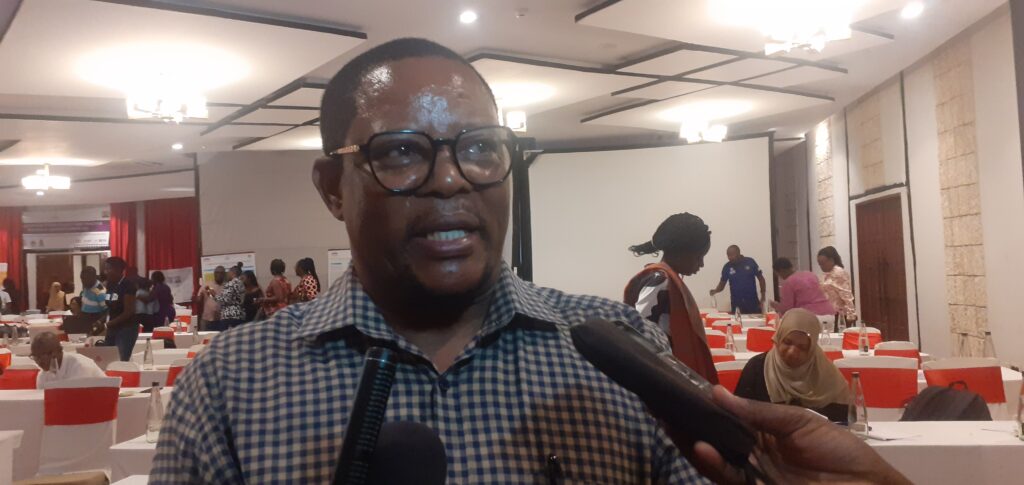By Caroline katana
A Non-governmental health project USAID Stawisha Pwani is calling upon county leadership in the coastal region to embrace best practices for fighting new HIV infections in the area.
According to the report released by the National Syendemic Diseases Control Council (NSDCC) formerly NACC, 10 counties of Nairobi, Kisumu, Homabay, Siaya, Migori, Nakuru, Mombasa, Kakamega, Kisii and Uasin Gishu, in that order, accounted for 57% of all new HIV infections recorded in 2021.
Speaking to journalists in Diani, Kwale County after best health intervention practices presentations by health workers, Stawisha Pwani project director Doctor Patrick Oyaro said the project is implemented in four counties in the coast region.
“The project seeks to strengthen county health systems with a focus on HIV and TB Prevention and Treatment, Reproductive, towards achieving sustainability in quality and systems of health services in the four coastal counties namely Kwale, Mombasa, Kilifi and Taita Taveta,” Said Oyaro.
Oyaro confirmed Mombasa County recorded the highest number of HIV infections in the coastal region.
“The prevalence is higher in Likoni, Changamwe, and Jomvu sub-counties, a factor attributed not only to larger populations in these sub-counties but also increased infrastructure activities occasioned by highways and main connection,” noted Oyaro.
He said the national government in collaboration with health partners has digitalized HIV prevention and treatment systems.
“According to research HIV patients can take up to one to six ARVs unlike before where they were entitled to one-month tablets and also health centers have embraced the use of computer systems to follow up with patients on ARVs usage,” said Oyaro.
Taita Taveta County Executive Committee Member in charge of health Gifton Mukaya said Taita-Taveta County has a higher HIV prevalence than the national average.
“The hotspots are along the main Mombasa-Nairobi highway such as Voi town and interactions at the border towns of Taveta and Holili that border Kenya and Tanzania respectively representing areas with higher HIV prevalence,” he said.
Taita Taveta County has an ART coverage of less than 70% and a mother-to-child transmission of more than 11.5%,” Said Mukaya
He said that the USAID Stawisha Pwani project also has boosted laboratory services in health centers to ensure the effective delivery of services.
“Stawisha Pwani has provided laboratory equipment in our health centers to ensure all samples of blood are diagnosed on time,” he said.
Stawisha Pwani is funding several HIV testing and counselors to provide services in the four counties.
Kwale County has a lower than national average prevalence but with an ART coverage of less than 70%.
The HIV incidence is high in the coastal strip sub-counties of Lunga, Msambweni, and Matuga the ease of access to health services on both sides of the Kenya –Tanzania border at Lunga Lunga also makes it defaulter.
In Kilifi County, the HIV prevalence is lower than the national average with an ART coverage of more than 80%. The prevalence, however, is higher in the urban areas of Malindi, Kilifi, Watamu, Majengo, Maleleni, Mtwapa, Mariakani, and Kaloleni towns compared to rural ones.
This county, in particular, is associated with early sexual debut which fuels the feminization of HIV.
It is estimated that 55% of persons reported having had their first sexual interaction before the age of 15 years.
Key populations carry a high HIV burden as the prevalence ranges between 15% and 25%, much higher than averages in the four counties and nationally.
They comprise men who have sex with men (MSMs), people who inject drugs (PWIDs), female sex workers (FSWs) and their clients, and prison populations.
The three counties of Mombasa, Kilifi and Kwale have a high proportion of KPs with all three counties having programs for people who inject drugs and clinics for medically assisted therapy.
Priority populations in the four counties include adolescents and young people (AYPs), women living in urban informal settlements, truck drivers, street children, people with disabilities (PWDs), mobile workers, people working in settings of traditional alcoholic brews, mining, and plantation workers, and the fishing communities.
For adolescents, in particular, sex with older partners, and multiple partners are among the factors influencing HIV infections.
Availability and access to family planning/maternal, newborn, child and adolescent health (FP/RMNCAH) services is essential for reducing HIV transmission.
Kwale County, the priority county for FP/RMNCAH interventions has multiple challenges that affect the uptake of HIV and FP/RMNCAH services.
A poor road network and long distances to health facilities limit the accessibility of health services.
Other barriers include economic, socio-cultural, and political factors, lack of access to accurate information, and quality of care.


